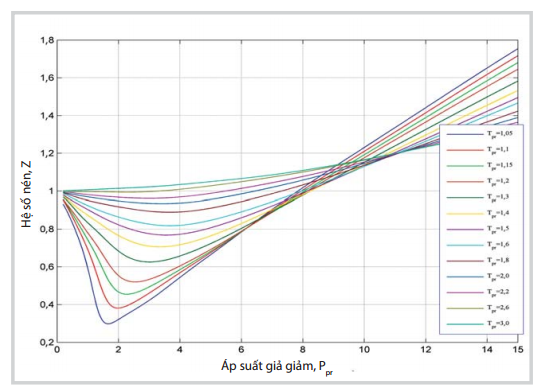Sử dụng mạng neural nhân tạo để dự đoán hệ số Z cho khí hydrocarbon thiên nhiên
Tóm tắt
Hệ số nén khí hay hệ số lệch khí (hệ số Z) là thông số quan trọng để xác định tính chất nhiệt động của vỉa khí, tỷ trọng khí, độ nhớt khí, độ nén khí, mô phỏng vỉa khí, tính toán cân bằng vật chất, dự đoán PVT cho giếng dầu và khí… Dựa trên dữ liệu từ biểu đồ Standing-Katz, một số phương pháp đã được phát triển để tính hệ số Z [1 - 3]. Dựa trên phương pháp của Mohammadreza Kamyab [4], nhóm tác giả đã tính toán, xác định hệ số Z bằng mạng neural nhân tạo (ANN) với thông số đầu vào gồm áp suất giả giảm và nhiệt độ giả giảm của 5.940 điểm dữ liệu thực nghiệm [5]. Kết quả nghiên cứu cho thấy mô hình này có thể dự đoán chính xác hệ số Z hơn so với các phương pháp khác và có khả năng áp dụng trên phạm vi nhiệt độ giả giảm 1,05 ≤ Tpr ≤ 3 và áp suất giả giảm 0,2 ≤ Ppr ≤ 15.
Các tài liệu tham khảo
2. R.A.Dranchuk, D.B.Purvis, P.M.Robinson. A reduced equation of state applied to generalized compress- ibility factor tables. Journal of Canadian Petroleum Technology. 1971.
3. D.H.Beggs, J.P.Brill. An experi- mental study of two-phase flow in in- clined pipes. Journal of Petroleum Tech- nology. 1973; 25(5): p. 607 - 617.
4. Mohammadreza Kamyab, Jorge H.B Sampaio Jr., Farhad Qan- baria, Alfred W.Eustes III. Using artificial neural networks to estimate the z-factor for naturalhydrocarbon gases. Elsevier. 2010.
5. D.L.Katz, D.Cornell. Handbook of natural gas engineering. New York: McGraw-Hill. 1959.
6. E.Sanjari, E.N.Lay. Estimation of natural gas compressibility factors using artificial neural network approach. Journal of Natural Gas Science and En- gineering. 2012; 9: p. 220 - 226.
7. E.Heidaryan, A.Salarabadi, J.Moghadasi. A novel correlation ap- proach for prediction of natural gas com- pressibility factor. Journal of Natural Gas Chemistry. 2010; 19(2): p. 189 - 192.
8. T.Ahmed. Reservoir engineering handbook. Gulf professional publish- ing. 2010.
9. A.Danesh. PVT and phase. Elsevier. 1998.
10. Y.A.Cengel, M.A. Boles. Ther- modynamics: An engineering approach. McGraw Hill. 2007.
11. N.Azizi, R.Behbahani, M.A.Isazadeh. An efficient correlation for calculating compressibility factor of natural gases. Journal of Natural Gas Chemistry. 2010; 19(6): p. 642 - 645.
12. E.Sanjari, E.N.Lay. An accurate empirical correla- tion for predicting natural gas compressibility factors. Joural of Natural Gas Chemistry. 2012; 21(2): p. 184 - 188.
13. L.A.Kareem. New explicit correlation for the com- pressibility factor of natural gas: linearized Z-factor iso- therms. Journal of Petroleum Exploration and Production Technology. 2015; 6(19): p. 1 - 12.
14. K.K.Dune, B.N.Oriji. A new computerized approach to Z-factordetermination. Transnational Journal of Sicience and Technology. 2012; 2(7): p. 64 - 80.
15. M.H.Beale, M.T.Hagan, H.B.Demuth. Neural net- work toolbox user's guide. The MathWorks. 2015.
16. S.Mohaghegh. Virtual-intelligence applications in petroleum engineering: Part 1- Artificial neural networks. Journal of Petroleum Technology. 2000; 52(9): p. 64 - 73.
17. K.Suzuki, A.Krenker, J.Bester, A.Kos. Introduction to the artificial neural networks in Artificial neural networks - Methodological advances and biomedical applications. In- Tech. 2011: p. 3 - 18.
18. S.Mohaghegh. Neural network: What it can do for petroleum engineers. Society of Petroleum Engineers. 1995; 47(1).
19. H.Esen, M.Inalli. Modelling of a vertical ground coupled heat pump system by using artificial neural net- works. Expert Systems with Applications. 2009; 36(7): p. 10229 - 10238.
20. A.Sozen, E.Arcaklioglu, E.G.Kanit. Use of artificial neural networks for mapping of solar potential in Turkey. Applied Energy. 2004; 77(3): p. 273 - 286.
21. A.H.Mohammadi, A.Kamari, F.Gharagheizi. A cor- responding states-based method for the estimation of natu- ral gas compressibility factors. Journal of Molecular Liquids. 2016; 216: p. 25 - 34.
22. M.B.Mohamad, A.Reza, O.Shahriar, Z.Zeinab. Pre- diction of gas compressibility factor using intelligent models. Natural Gas Industry B. 2015; 2(4): p. 283 - 294.
23. Hoàng Anh. Sự trỗi dậy của những cỗ máy. PC World VN. 8/2015.

1. Tác giả giao bản quyền bài viết (tác phẩm) cho Tạp chí Dầu khí, bao gồm quyền xuất bản, tái bản, bán và phân phối toàn bộ hoặc một phần tác phẩm trong các ấn bản điện tử và in của Tạp chí Dầu khí.
2. Bằng cách chuyển nhượng bản quyền này cho Tạp chí Dầu khí, việc sao chép, đăng hoặc sử dụng một phần hay toàn bộ tác phẩm nào của Tạp chí Dầu khí trên bất kỳ phương tiện nào phải trích dẫn đầy đủ, phù hợp về hình thức và nội dung như sau: tiêu đề của bài viết, tên tác giả, tên tạp chí, tập, số, năm, chủ sở hữu bản quyền theo quy định, số DOI. Liên kết đến bài viết cuối cùng được công bố trên trang web của Tạp chí Dầu khí được khuyến khích.




